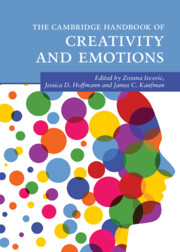Book contents
- The Cambridge Handbook of Creativity and Emotions
- Cambridge Handbooks in Psychology
- The Cambridge Handbook of Creativity and Emotions
- Copyright page
- Dedications
- Contents
- Figures
- Tables
- Contributors
- Acknowledgments
- Creativity and Emotions
- Part I Methods in the Study of Creativity and Emotions
- Part II The Development of Creativity
- Part III Emotions and the Creative Person
- Part IV Emotions and Creative Products
- Part V Emotions and Creativity at School and Work
- Index
- References
Creativity and Emotions
Introduction
Published online by Cambridge University Press: 16 February 2023
- The Cambridge Handbook of Creativity and Emotions
- Cambridge Handbooks in Psychology
- The Cambridge Handbook of Creativity and Emotions
- Copyright page
- Dedications
- Contents
- Figures
- Tables
- Contributors
- Acknowledgments
- Creativity and Emotions
- Part I Methods in the Study of Creativity and Emotions
- Part II The Development of Creativity
- Part III Emotions and the Creative Person
- Part IV Emotions and Creative Products
- Part V Emotions and Creativity at School and Work
- Index
- References
Summary
In the introductory chapter to the Cambridge Handbook of Creativity and Emotion, we define basic terms in the study of creativity and emotions. We argue about the need for specification of different aspects of creativity under investigation and caution scholars to make conclusions about specific aspects studied, rather than “creativity” in general. This Handbook examined three groups of affective processes: affective states (relatively short-lasting reactions to internal or external stimuli), emotion-related traits (typical ways of feeling), and emotion abilities (capacities to reason about and with emotions, such as in the case of emotional intelligence). Next, we describe the organization of this Handbook into five parts, each addressing a different aspect in the study of creativity, including methodological issues, creative process, creative person, creative product, and creative contexts (school and work). The concluding chapter presents an integrative model of the role of affective processes across aspects of creativity.
Keywords
- Type
- Chapter
- Information
- Publisher: Cambridge University PressPrint publication year: 2023



